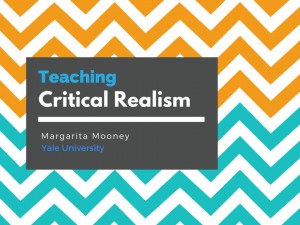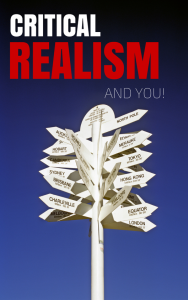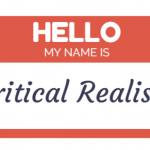 This is the third of three blogs in which I list 23 readings we could use to teach about the methodological implications of CR. Don’t forget to register for my webinar in CR & Research Methods on May 3, 2016, at 12 noon EDT (you can see the recording even if you can’t be there live). And click here to see the first blog in this series. Click here to see the second blog in this series. And click here to see the fourth.
This is the third of three blogs in which I list 23 readings we could use to teach about the methodological implications of CR. Don’t forget to register for my webinar in CR & Research Methods on May 3, 2016, at 12 noon EDT (you can see the recording even if you can’t be there live). And click here to see the first blog in this series. Click here to see the second blog in this series. And click here to see the fourth.
In my upcoming webinar on critical realism and research methods, I plan to propose 2 ways to incorporate CR into research methods classes. Remember, CR is not another form of foundationalism (the idea that there is one right way to view knowledge). It’s not like if we don’t use CR as our meta-theory then we can’t say anything true about the world. There are plenty of similarities between CR and other theories. It’s more like CR+ (i.e., CR brings to light new perspectives) or CR-integrate (i.e., CR helps us integrate insights gained from a variety of perspectives or methods).
I hope these articles, and my webinar, show that CR takes what is useful from all methods and all perspectives. But CR also sheds new light on what we do in sociology. CR goes further into abstraction, concept development, retroductive logic, and theory building. CR thus leads to better questions, more compelling explanations, all the while being humble and open to new perspectives and knowledge.
One option to teach the methodological implications of CR is to add readings on CR to already existing courses on research methods. CR does a particularly good job of talking about how ontology (or what exists in the world, seen or unseen) is different than epistemology (which is what we observe). CR also tells us why our ontology matters for things all sociologists care about: causation (the identification of causal powers) and explanation (which includes causation and interpretation).
It’s often said that CR under-labors in good social science. A second option to teach about the methodological impactions of CR is to use CR as a framework to understand the methods and theories of good published sociology books and articles (whether or not the author identifies CR as their meta-theroetical framework). These book chapters or articles on CR & research methods can help show how the best sociology already sounds like CR. Students can also read other perspectives on social science, such as positivism, intepretivism, pragmatism, etc. and then ask: Which perspective best explains the theory, methods, and conclusions in the best books or articles in sociology? Why? CR itself is not a method, but as the articles and book chapters below show, CR offers a better way to understand what we are really doing when we do ethnography, grounded theory, interviews, historical research, small-N case studies, mixed-methods studies, quantitive studies, or evaluation research.
Below are my favorite articles or book chapters on CR and research methods by topic. I think these articles and book chapters could be used in either type of class. These articles and book chapters are likely also helpful for your own research. This list is not comprehensive, so feel free to share with me your favorite articles or book chapters on CR & research methods which are not listed here.
And don’t forget to register for my webinar on April 28, 2016, at 12 noon EDT to learn more. You should register to listen to the recording even if you can’t be there live.
Here you go!
Overviews of CR as a research method
Sayer, Andrew. 1992. Method in Social Science: A Realist Approach. London: Routledge. Introduction and Chapter 1.
Pawson, Ray. 2016. Evidence-Based Policy: A Realist Perspective. London: Sage Publications. Chapter 2.
Edwards, P., O’Mahoney, J. and Vincent, S. eds. (2014). Studying Organizations Using Critical Realism: A Practical Guide. Oxford: Oxford University Press Chapter. 1 “CR as an Empirical Project.”
Edwards, P., O’Mahoney, J. and Vincent, S. eds. (2014). Studying Organizations Using Critical Realism: A Practical Guide. Oxford: Oxford University Press. Chapter 2 “CR, Research Techniques and Research Designs.”
CR & Ethnography
Claire Laurier Decouteau (2016) “The AART of Ethnography: A Critical Realist Explanatory Research Model.” Journal for the Theory of Social Behaviour. March 2016.
Edwards, P., O’Mahoney, J. and Vincent, S. eds. (2014). Studying Organizations Using Critical Realism: A Practical Guide. Oxford: Oxford University Press Chapter 7. Chris Rees and Mark Gatenby. (2014). “Critical Realism and Ethnography.”
CR & Grounded Theory
Danermark, B. Ekström, M. Jakobsen, L. Karlsson. J.C. (1997) Explaining Society: An Introduction to Critical Realism in the Social Sciences. London: Routledge. Chapter 6 “Theory in the Methodology of Social Science”, pp. 130-137.
Edwards, P., O’Mahoney, J. and Vincent, S. eds. (2014). Studying Organizations Using Critical Realism: A Practical Guide. Oxford: Oxford University Press Chapter 5. Steve Kempster and Ken Perry. “Critical Realism and Grounded Theory.”
CR & Interviews
Margarita Mooney (2016) “Moral Agency and Mental Illness.” Paper Currently Under Review. (available from the author upon request).
Edwards, P., O’Mahoney, J. and Vincent, S. eds. (2014). Studying Organizations Using Critical Realism: A Practical Guide. Oxford: Oxford University Press Chapter 6. Chris Rees and Tony Elger. “Critical Realism and Interviewing Subjects.”
CR & Historical-Comparative Research
George Steinmetz. (2003) “Odious Comparisons: Incommensurability, the Case Study, and Small N’s in Sociology.” Sociological Theory, Vol. 22, number 3, pp. 371-400.
George Steinmetz. (2008). “The Colonial State as a Social Field.” American Sociological Review 73(4): pp. 589–612.
George Steinmetz. (2014). “Comparative History and its Critics: A Genealogy and a Possible Solution.” In A Companion to Global Historical Thought, edited by Prasenjit Duara, Viren Murthy and Andrew Sartori. Blackwell. Pp. 412-436.
George Steinmetz. (1998) “Critical Realism and Historical Sociology.” Comparative Studies in Society and History volume 40, number 1, pp. 170-186.
CR & Mixed Methods
Bhaskar, R. and Danermark, B. (2006). ‘Metatheory, Interdisciplinarity and Disability Research: A Critical Realist Perspective’, Scandinavian Journal of Disability Research, 8: 4, pp 278 – 297.
Danermark, Berth, et al. 2001. Explaining Society: An Introduction to Critical Realism in the Social Sciences. Routledge. Chapter 6 “Critical Methodological Pluralism” esp. Pp. 161-176.
CR & Quantitative Methods
Sayer, A. 1992. Method in Social Science: A Realist Approach. London: Routledge. Chp. 6 “Quantitative Methods in Social Science.”
Lawson, Tony. (1997). Economics and Reality. New York: Routledge. Chapter 15. “Economic Science Without Experimentation.”
Porpora, Douglas. (2015). Reconstructing Sociology: A Critical Realist Approach. Cambridge: Cambridge University Press. Chapter 2. “Do Realists Run Regressions?”
CR Views of Explanation, Especially as Compared to Deductive or Inductive Explanations
Lawson, T. (1997). Economics and Reality. New York: Routledge. Chapter 2. “Realism, Explanation and Science.”
Sayer, A. 1992. Method in Social Science: A Realist Approach. London: Routledge. Chapter 9. “Problems of Explanation and the Aims of Social Science.”
Danermark, Berth, et al. Explaining Society: An Introduction to Critical Realism in the Social Sciences. Routledge, 2001. Chapter 4 “Generalization, scientific inference and models for an explanatory social science” pp. 73-106-114, especially Table 4.
Realist Evaluation Research
Pawson, Ray. 2016. Evidence-Based Policy: A Realist Perspective. London: Sage Publications. Pawson, Chp. 4 “Realist Synthesis: New Protocols for Systematic Review”.
To learn more, don’t forget to register for my webinar in CR & Research Methods on April 28, 2016, at 12 noon EDT (you can see the recording even if you can’t be there live). You should also read my blog about my presentation on CR & Research Methods from IACR 2015.










